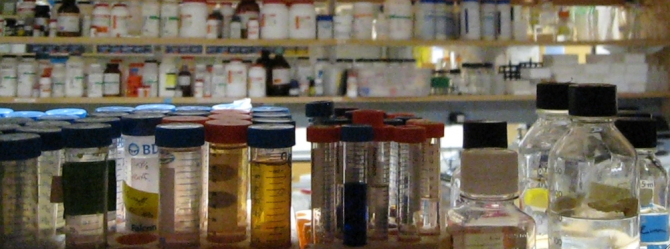Difference between revisions of "20.109(S08):Induce protein expression (Day4)"
(→Introduction) |
|
(No difference)
| |
Revision as of 22:43, 2 January 2008
Contents
Introduction
Remind how IPTG works; discuss places where protein folding/production may go wrong; probably discuss sequencing on this day.
Protocols
Analyze sequencing data first (can we get it in time)??
Part 1: Cell measurement and IPTG induction
- For each mutant protein, you will be given a 5 mL aliquot of DE3 cells carrying the mutant plasmid; you will also receive a tube of DE3 carrying wild-type inverse pericam. These cells should be in or close to the mid-log phase of growth for good induction, just as they were for transformation. Like last time, check the OD600 value of your cells until it falls between 04.and 06. (Better to overshoot a little than undershoot.)
- Once your cells have reached the appropriate growth phase, set aside 1.5 mL of cells from each tube as a control (no IPTG) sample. Then take an aliquot of cold IPTG (0.1 M), and add to your remaining cells at a final concentration of 1 mM. You should prepare two mutant and one wild-type tube.
- If we do not receive the sequencing results in time, you will prepare two mutant tubes, one from each colony that was picked from your mutagenesis reaction. We will figure out later which one to purify.
- Return your tubes to the 37 °C incubator, and note down the time.
Part 2: Modeling exercise
Orr... have Atissa come in today to give talk on oral presentations. Save modeling for day 7...?
Part 3: Cell observation and collection
- After 2.5 hours, you will pour 1.5 mL from each tube into a labeled eppendorf, then spin for 1 min. at maximum speed. Save the other 2 mL!
- Aspirate the supernatant from each eppendorf, using a fresh yellow pipet tip on the end of the glass pipet each time.
- Observe the colour of each of your pellets. If both the wild-type and the mutant pellets appear yellow-greenish to the eye, go ahead and give these to the teaching staff to be frozen.
- If one or more of your pellets are white or only dimly coloured, please ask one of the teaching staff too show you the room temperature rotary shaker in the back room. You will continue to grow your bacteria overnight. Tomorrow morning, the teaching staff will collect your pellets for you and freeze them.
Part 4: Preparation for next time
Next time, you will lyse your bacterial samples to release their proteins, and run these out on a gel protein gel. In order to compare the amount of protein in the -IPTG versus +IPTG samples, you would like to normalize by the number of cells. At this point, you may have only three samples ready (-IPTG only), or you may have all six. In either case, measure the OD600 of a 1:10 dilution of cells for each finished sample, and write this number down in your notebook. Then spin down the cells and aspirate the supernatant.
